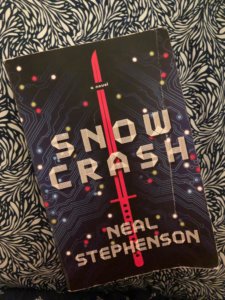Posts Tagged ‘language’
Writing Dynamic Non-Humanoid Aliens, Part 3 of 4
Today, I look at China Miéville’s, EMBASSYTOWN. Beware of spoilers. This won’t be a review of the novel, but a study of the Ariekei, the aliens indigenous to the planet Arieka.
First, a little advice…If you have the opportunity, consume EMBASSYTOWN via audiobook. To buy EMBASSYTOWN via Audible, click here. To buy the physical novel, EMBASSYTOWN click here. Language is central to the story, but the Ariekei language is best experienced when heard rather than read, therefore my encouragement to read via Audible. The Ariekei (also known as the hosts) speak from two mouths at once. One mind, but two words emerge from the creature when it vocalizes. In the audio reading, the sound producers overlay two words spoken at once, like hearing two notes played at the same time. The effect is marvelous and strange.
For a synopsis: One human culture, the Bremen, has adapted and figured out a method of speaking with and listening to the indigenous population of Arieka, a planet on the edge of the known universe. Their motivation for doing so is to maintain a colony on Arieka. Like a typical colonial power, the Bremen dig for metals and also trade with the Ariekei, whose biotech is advanced and valuable across the known universe. The Ariekei are advanced in many respects, but their language does not allow them to lie or even speculate.
Conflict arises in EMBASSYTOWN when one Bremen ambassador introduces lying into the Ariekei language. He does this in the hopes of taking control of the host population, but chaos ensues. The main character, a woman named Avice Benner Cho, steps in to save those living on the planet, both human and Ariekei.
How does Miéville give the aliens, the Areikei, personality and tap into audience empathy?
- Similar to the film Arrival (see post 2 of 3), point of view is key. POV rests in one human character who is relatable. Avice narrates this tale in the first person. Not only is she human, she was raised on Arieka and is known by the indigenous population. She is returning to her home after many years of traveling through space. Avice is the “in between” character. She describes, interprets and translates for the audience.
- Miéville finds colorful shorthand ways of describing the physical and personality attributes of particular Ariekei. Miéville, through his narrator, Avice gives the aliens nicknames, like Spanish Dancer. It’s genius because this shorthand gives the audience color, shape and depth to individual Ariekei and is so much better than than referring to all of them as “insect-horse-coral-fan things” another set of descriptors Avice muses on in the novel. An artist’s rendering in the top image is not necessarily what I had imagined when I pictured the Spanish Dancer, but Miéville doesn’t need me to have that specific picture in my mind. The broad brush strokes are there in the nickname and not just any nickname…calling the creature a dancer implies grace and dignity. The name takes an alien that might be perceived as monstrous and draws our attention to its beauty and gentleness. Maybe this is why ocean scientists call the sea creature (pictured above) a Spanish Dancer. The moniker is descriptive and if I’m visiting an aquarium staring at this thing through glass, if I am thinking of dancers instead of monsters, my eyes are drawn to its beauty. Miéville is doing the same thing when he has Avice call one particular Ariekei, The Spanish Dancer.
- The Ariekei have known Avice since she was a child. Avice has a positive association with the Ariekei. She was raised on their planet and thrived. Humans and Ariekei have lived together for many years in peace. This underlying truth makes a difference in how the audience feels about the Ariekei.
- The Ariekei are vulnerable to human abuse. The narrative of indigenous people groups used and abused by empires and greedy civilizations is not an uncommon story for the current sci-fi reading audience. Miéville dips into that narrative in this novel, portraying the aliens as complex, but also also as innocent, in large part because their language makes it impossible for them to lie. The audience empathizes with the vulnerable indigenous population. The narrative of “empire” taking over the “innocents” and using them for its own gain is familiar. That story taps into the audience’s empathy and our empathy lies with the Ariekei in this case.
- Avice relates to individual Ariekei, Miéville’s way of showing the audience that the Ariekei are not a monolith. Spanish Dancer is the most important Ariekei to the story, but there are others. As Avice relates to her and describes her and other Ariekei, the audience recognizes that though they are different from humans, the Ariekei are not all the same as one another. They are distinct in appearance and personality just as human beings are distinct from one another. (contrast this reality with the hive mind aliens, like the Formics in the Ender’s Game series, or the big computer brain of the Cylons “toasters” in Battle Star Galactica television series. I will tackle hive mind aliens in my final post on this topic.
SNOW CRASH, A Review Without Spoilers
SNOW CRASH, by Neal Stephenson was put before me by a member of my sci-fi book group. It’s my second exposure to cyber punk and I enjoyed the ride (in part). This novel, if turned into film, would likely be rated R. I recommend SNOW CRASH with reservations.
My Review in Two Parts
Why read SNOW CRASH?… 4 Reasons for YES!
- The world-building is remarkable and for many sci-fi fans Neal Stephenson is a must-read author in the cyberpunk sub-genre. I absolutely loved the beginning. The entry into this world felt fresh and dynamic. The first 50 pages (at least) will have you riveted.
- The action scenes are numerous and mostly well-timed and well-written. The action begins on the first page and sets the tone for the rest of the story.
- The intersection of virtual reality (Stephenson calls VR the Metaverse…he claims to be the originator of this term) and physical reality feels fluid and actually not that weird now (though it was a genuinely futuristic concept when he published the novel in 1992).
- Stephenson unearths some original and fantastical ideas. Some folks will love the philosophical bent of the story, having to do with ancient and current religions, computer coding, language as code and viruses that cross from virtual reality into the physical world.
Why avoid SNOW CRASH?…4 Reasons for No!
- Shallow characters inhabit this book. The world-building went deep, but the emotional depth and intelligence of the characters bored me.
- (related to reservation #1) The characters, especially the primary characters, did not have any real physical or mental weaknesses. They were superheroes. In fact, the protagonist is called Hiro Protagonist. By naming the main character Hiro, Stephenson is channeling the comic book/superhero genre. Having read about the development of the novel, that enlightens my critique. Stephenson began this book hoping to make it a graphic novel. He envisioned superhero-like characters, but even Superman must have his longing (Lois), his vulnerability (kryptonite) and face a villain who understands how to use these vulnerabilities to press the hero to the point of making a moral choice about his/her power. Though Stephenson’s characters get banged up here and there, I never felt they might actually be in danger or that they feared for their own lives. They took their beatings in stride. Moreover, I never felt there were emotional stakes for either of them (the secondary character is called YT…she is a skateboard delivery person). Hiro’s and YT’s motivations for putting everything on the line to save the world did not seem to connect to any ounce of characterization that I understood.
- Stephenson’s bad/shallow theology was disappointing for me. I will assume that Stephenson did his homework in regard to Sumerian religion and philosophy. (I deduce this from reading his acknowledgments). However, I hang out with a number of Christian thinkers because I’m married to one, and Stephenson’s characterization of Biblical theology is weak and ill informed. I don’t mind critiques of my religion, I even enjoy them if they are well thought out. Stephenson’s were not.
- The info-dump sections were enormous, boring and preachy. A cyber librarian is the character in the Metaverse who does the explaining to Hiro Protagonist, therefore to us. It’s a clever idea to use the librarian, but his information still comes in large chunks and disrupts the drama. Info-dumps are a huge temptation for sci-fi writers. I struggle with it myself. It’s difficult to build the world, explain the conflict, the problem that will drive the narrative and incorporate all your own ideas/themes without taking up scores of pages explaining stuff to your audience, but great writers tell us that the info dump method is lazy writing. There are other ways to do it! See an earlier post on allscifi that discusses Jemisin’s chosen method for handling backstory in the narrative. Good friend and fellow sci-fi writer, Lit Prof Liam Corley is a Jemisin fan and wrote this post a couple of weeks ago.
In short. If you’re a sci-fi nut/nerd, YES…read SNOW CRASH, but if you’re a literary person wandering around in sci-fi…read Octavia Butler, Jemisin, Le Guin, Vandermeer, Scalzi…almost anyone, but Stephenson.
To buy SNOW CRASH…click here.
ARRIVAL, Film Review Without Spoilers

ARRIVAL is rated PG 13…it’s somewhat creepy and suspenseful, but a middle school child or a sensitive viewer could probably handle the production. I’m not sure why it did not receive the PG rating. It unfolds without graphic violence and there is no explicit sexual content. One might call ARRIVAL a quiet film, but the subject matter takes it from the quiet realm into the epic and deeply thoughtful.
ARRIVAL was released in theaters to much acclaim in 2016. The film is based on a short story by Ted Chiang. Eric Heisserer wrote the screenplay. I hope to read and review Chiang’s short story in a future post.
The film unfolds with slow intensity primarily around one character, Louise Banks, played wonderfully by Amy Adams. Banks is a linguist recruited by the US government to learn the language spoken by aliens who have alighted in giant oblong space ships in twelve locations around the globe.
The story is a linguist’s dream and as a science fiction fan, I recall a number of novels that view first contact in light of language and communication. China Miéville’s Embassy Town is a good example. In a story such as this, violence is often threatened, but not center stage. Mysteries and the push to understand the other dominate the narrative.
Five quotes from the screenplay to pique your interest:
- “If this is some sort of peaceful first contact, why send twelve? Why not just send one?”
- “Language is the first weapon drawn in a conflict…”
- “Are they scientists or tourists? If they’re scientist, they don’t seem to ask a lot of questions…”
- “If you could see your life from start to finish, would you change things?”
- “Meeting you…was more important that seeing the stars…”
Five reasons to watch this film.
- It’s free if you’re an Amazon Prime member.
- If your family is into science fiction, ARRIVAL is a crowd pleaser which you can show to your kids with a clear conscience.
- Lots to ponder about language and linguistics, language and meaning, the puzzle and the importance of communication.
- Female hero with lots of brains and only a few characters to keep track of.
- Potentially leads to fruitful discussion about love, suffering, beauty, grace, even religion.
To buy this DVD, click here.




